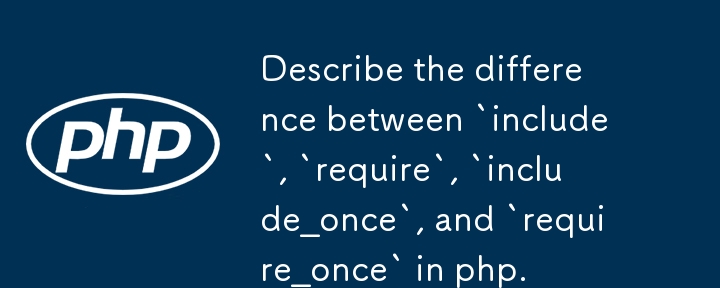 Backend Development
Backend Development
 PHP Tutorial
PHP Tutorial
 Describe the difference between `include`, `require`, `include_once`, and `require_once` in php.
Describe the difference between `include`, `require`, `include_once`, and `require_once` in php.
Describe the difference between `include`, `require`, `include_once`, and `require_once` in php.
Jul 11, 2025 am 12:53 AMIn PHP, the main differences between include, require and their \_once versions are in the error handling method and whether the file is loaded repeatedly. 1. include warns when the file cannot be found but the script continues to be executed; 2. require throws a fatal error and terminates the script; 3. include\_once and require\_once respectively ensure that the file is loaded only once during the entire script life cycle to avoid repeated definition errors; 4. The selection is based on whether the file must exist and whether it is possible to introduce it repeatedly.

In PHP, include , require , include_once and require_once are all used to introduce external files. But there are key differences between them, especially in terms of error handling and whether to load files repeatedly.

include vs require
The difference between the two is mainly reflected in the different ways of handling errors when the file cannot be found .
-
include: If the included file does not exist or the path is wrong, PHP will issue a warning (Warning) , but the script will continue to execute. -
require: If the file cannot be found, PHP will throw a fatal error (Fatal Error) and the entire script will stop running.
For example:

include 'missing-file.php'; // Output a warning, continue to execute echo "continue executing code"; require 'missing-file.php'; // Report an error and terminate the script echo "This line will not be executed";
Therefore, when you need to make sure that a file must exist to continue executing the program (such as configuration files or core library), you should use require ; and when used for optional content, it is more appropriate to include .
The function of _once version: prevent duplicate loading
Sometimes you may refer to the same file in multiple places, such as a public function library or configuration file. If no control is added, multiple loading may cause errors such as repeated definitions of functions.

At this time, you need to use the version with _once :
-
include_once: Only load the specified file when called for the first time in the current script, and subsequent calls are ignored. -
require_once: works likerequire, but it also ensures that the file is loaded only once throughout the script lifecycle.
Examples of usage scenarios:
require_once 'config.php'; // Even if it is called in multiple places, requires_once 'functions.php' will only be loaded once;
This writing can avoid errors like "function already defined" and is especially useful in large projects.
How to choose?
Simply put, you can make a judgment based on the following points:
- Does the file have to exist?
- Yes → Use
requireorrequire_once - No → Use
includeorinclude_once
- Yes → Use
- Is it possible to introduce it repeatedly?
- Yes → Priority to use
_onceversion - No → Normal version
- Yes → Priority to use
Also, in terms of performance, the _once version will be slightly slower because PHP wants to record which files have been loaded. But in actual development, this difference is almost negligible.
Basically that's it. As long as you understand the two dimensions of "error behavior" and "whether to load repeatedly", you can know when to use which statement.
The above is the detailed content of Describe the difference between `include`, `require`, `include_once`, and `require_once` in php.. For more information, please follow other related articles on the PHP Chinese website!

Hot AI Tools

Undress AI Tool
Undress images for free

Undresser.AI Undress
AI-powered app for creating realistic nude photos

AI Clothes Remover
Online AI tool for removing clothes from photos.

Clothoff.io
AI clothes remover

Video Face Swap
Swap faces in any video effortlessly with our completely free AI face swap tool!

Hot Article

Hot Tools

Notepad++7.3.1
Easy-to-use and free code editor

SublimeText3 Chinese version
Chinese version, very easy to use

Zend Studio 13.0.1
Powerful PHP integrated development environment

Dreamweaver CS6
Visual web development tools

SublimeText3 Mac version
God-level code editing software (SublimeText3)

Hot Topics
 Using std::chrono in C
Jul 15, 2025 am 01:30 AM
Using std::chrono in C
Jul 15, 2025 am 01:30 AM
std::chrono is used in C to process time, including obtaining the current time, measuring execution time, operation time point and duration, and formatting analysis time. 1. Use std::chrono::system_clock::now() to obtain the current time, which can be converted into a readable string, but the system clock may not be monotonous; 2. Use std::chrono::steady_clock to measure the execution time to ensure monotony, and convert it into milliseconds, seconds and other units through duration_cast; 3. Time point (time_point) and duration (duration) can be interoperable, but attention should be paid to unit compatibility and clock epoch (epoch)
 How does PHP handle Environment Variables?
Jul 14, 2025 am 03:01 AM
How does PHP handle Environment Variables?
Jul 14, 2025 am 03:01 AM
ToaccessenvironmentvariablesinPHP,usegetenv()orthe$_ENVsuperglobal.1.getenv('VAR_NAME')retrievesaspecificvariable.2.$_ENV['VAR_NAME']accessesvariablesifvariables_orderinphp.iniincludes"E".SetvariablesviaCLIwithVAR=valuephpscript.php,inApach
 Why We Comment: A PHP Guide
Jul 15, 2025 am 02:48 AM
Why We Comment: A PHP Guide
Jul 15, 2025 am 02:48 AM
PHPhasthreecommentstyles://,#forsingle-lineand/.../formulti-line.Usecommentstoexplainwhycodeexists,notwhatitdoes.MarkTODO/FIXMEitemsanddisablecodetemporarilyduringdebugging.Avoidover-commentingsimplelogic.Writeconcise,grammaticallycorrectcommentsandu
 PHP header redirect not working
Jul 14, 2025 am 01:59 AM
PHP header redirect not working
Jul 14, 2025 am 01:59 AM
Reasons and solutions for the header function jump failure: 1. There is output before the header, and all pre-outputs need to be checked and removed or ob_start() buffer is used; 2. The failure to add exit causes subsequent code interference, and exit or die should be added immediately after the jump; 3. The path error should be used to ensure correctness by using absolute paths or dynamic splicing; 4. Server configuration or cache interference can be tried to clear the cache or replace the environment test.
 PHP prepared statement get result
Jul 14, 2025 am 02:12 AM
PHP prepared statement get result
Jul 14, 2025 am 02:12 AM
The method of using preprocessing statements to obtain database query results in PHP varies from extension. 1. When using mysqli, you can obtain the associative array through get_result() and fetch_assoc(), which is suitable for modern environments; 2. You can also use bind_result() to bind variables, which is suitable for situations where there are few fields and fixed structures, and it is good compatibility but there are many fields when there are many fields; 3. When using PDO, you can obtain the associative array through fetch (PDO::FETCH_ASSOC), or use fetchAll() to obtain all data at once, so the interface is unified and the error handling is clearer; in addition, you need to pay attention to parameter type matching, execution of execute(), timely release of resources and enable error reports.
 PHP check if a string starts with a specific string
Jul 14, 2025 am 02:44 AM
PHP check if a string starts with a specific string
Jul 14, 2025 am 02:44 AM
In PHP, you can use a variety of methods to determine whether a string starts with a specific string: 1. Use strncmp() to compare the first n characters. If 0 is returned, the beginning matches and is not case sensitive; 2. Use strpos() to check whether the substring position is 0, which is case sensitive. Stripos() can be used instead to achieve case insensitive; 3. You can encapsulate the startsWith() or str_starts_with() function to improve reusability; in addition, it is necessary to note that empty strings return true by default, encoding compatibility and performance differences, strncmp() is usually more efficient.
 how to avoid undefined index error in PHP
Jul 14, 2025 am 02:51 AM
how to avoid undefined index error in PHP
Jul 14, 2025 am 02:51 AM
There are three key ways to avoid the "undefinedindex" error: First, use isset() to check whether the array key exists and ensure that the value is not null, which is suitable for most common scenarios; second, use array_key_exists() to only determine whether the key exists, which is suitable for situations where the key does not exist and the value is null; finally, use the empty merge operator?? (PHP7) to concisely set the default value, which is recommended for modern PHP projects, and pay attention to the spelling of form field names, use extract() carefully, and check the array is not empty before traversing to further avoid risks.
 PHP prepared statement with IN clause
Jul 14, 2025 am 02:56 AM
PHP prepared statement with IN clause
Jul 14, 2025 am 02:56 AM
When using PHP preprocessing statements to execute queries with IN clauses, 1. Dynamically generate placeholders according to the length of the array; 2. When using PDO, you can directly pass in the array, and use array_values to ensure continuous indexes; 3. When using mysqli, you need to construct type strings and bind parameters, pay attention to the way of expanding the array and version compatibility; 4. Avoid splicing SQL, processing empty arrays, and ensuring data types match. The specific method is: first use implode and array_fill to generate placeholders, and then bind parameters according to the extended characteristics to safely execute IN queries.





